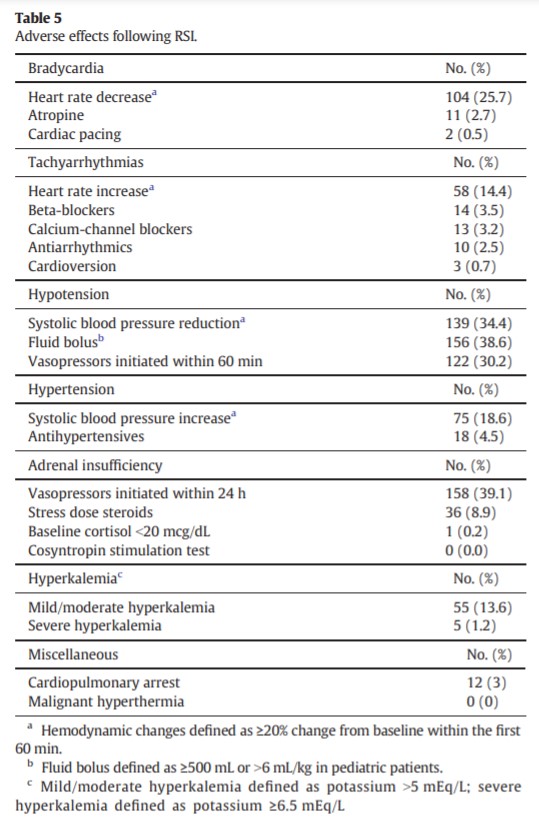Groth CM, Acquisto NM, Khadem T. Current practices and safety of medication use during rapid sequence intubation. J Crit Care. 2018 Jun;45:65-70.
“A total of 404 patients from 34 geographically diverse institutions were included (mean age 58 ± 22 years, males 59%, pediatric 8%). During RSI, 21%, 87%, and 77% received pre-induction, induction, and paralysis, respectively. Significant differences in medication use by provider type were seen. Etomidate was administered to 58% with sepsis, but was not associated with adrenal insufficiency. Ketamine was associated with hypotension post-RSI [RR = 1.78 (1.36–2.35)] and use was low with traumatic brain injury/stroke (1.5%). Succinylcholine was given to 67% of patients with baseline bradycardia and was significantly associated with bradycardia post-RSI [RR = 1.81 (1.11–2.94)]. An additional 13% given succinylcholine had contraindications. Sedation practices post-RSI were not consistent with current practice guidelines and most receiving a non-depolarizing paralytic did not receive adequate sedation post-RSI.”
Stollings JL, et al. Rapid-sequence intubation: a review of the process and considerations when choosing medications. Ann Pharmacother. 2014 Jan;48(1):62-76.
Full-text for Emory users.
Smith TL, Van Meter J. Maximizing Success With Rapid Sequence Intubations. AENJ. 2018 Jul/Sep;40(3):183-193.
Full-text for Emory users.
“Within emergency care settings, rapid sequence intubation (RSI) is frequently used to secure a definitive airway (i.e., endotracheal tube) to provide optimal oxygenation and ventilation in critically ill patients of all ages. For providers in these settings, a deeper understanding of the indications, associated medications, and adjunctive techniques may maximize success with this common procedure. Identification of difficult airways, using mnemonics and standardized criteria prior to the procedure allows, the clinician additional time for assimilation of additional resources and tools to increase the likelihood of first-pass success with intubation. This article describes tools for the procedure of RSI, including the “7 Ps” checklist of intubation.”
More PubMed results on RSI.



